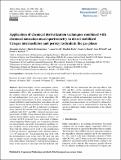Application of chemical derivatization techniques combined with chemical ionization mass spectrometry to detect stabilized Criegee intermediates and peroxy radicals in the gas phase
Author(s)
Zaytsev, Alexander; Breitenlechner, Martin; Novelli, Anna; Fuchs, Hendrik; Knopf, Daniel A; Kroll, Jesse H; Keutsch, Frank N; ... Show more Show less
DownloadPublished version (496.1Kb)
Publisher with Creative Commons License
Publisher with Creative Commons License
Creative Commons Attribution
Terms of use
Metadata
Show full item recordAbstract
Abstract. Short-lived highly reactive atmospheric species, such as organic peroxy radicals (RO2) and stabilized Criegee intermediates (SCIs), play an important role in controlling the oxidative removal and transformation of many natural and anthropogenic trace gases in the atmosphere. Direct speciated measurements of these components are extremely helpful for understanding their atmospheric fate and impact. We describe the
development of an online method for measurements of SCIs and RO2 in
laboratory experiments using chemical derivatization and spin trapping
techniques combined with H3O+ and NH4+ chemical
ionization mass spectrometry (CIMS). Using chemical derivatization agents
with low proton affinity, such as electron-poor carbonyls, we scavenge all
SCIs produced from a wide range of alkenes without depleting CIMS reagent
ions. Comparison between our measurements and results from numeric
modeling, using a modified version of the Master Chemical Mechanism, shows
that the method can be used for the quantification of SCIs in laboratory
experiments with a detection limit of 1.4×107 molecule cm−3
for an integration time of 30 s with the instrumentation used in this study. We
show that spin traps are highly reactive towards atmospheric radicals and
form stable adducts with them by studying the gas-phase kinetics of the
reaction of spin traps with the hydroxyl radical (OH). We also demonstrate that spin trap
adducts with SCIs and RO2 can be simultaneously probed and quantified under laboratory conditions with a detection limit of 1.6×108 molecule cm−3 for an integration time of 30 s for RO2 species with the instrumentation used in this study. Spin trapping prevents radical secondary reactions and cycling, ensuring that measurements are not biased by chemical interferences, and it can be implemented for detecting RO2 species in laboratory studies and potentially in the ambient atmosphere.
Date issued
2021-03Department
Massachusetts Institute of Technology. Department of Civil and Environmental EngineeringJournal
Atmospheric Measurement Techniques
Publisher
Copernicus GmbH
Citation
Zaytsev, A., Breitenlechner, M., Novelli, A., Fuchs, H., Knopf, D. A., Kroll, J. H., and Keutsch, F. N.: Application of chemical derivatization techniques combined with chemical ionization mass spectrometry to detect stabilized Criegee intermediates and peroxy radicals in the gas phase, Atmos. Meas. Tech., 14, 2501–2513, 2020
Version: Final published version
ISSN
1867-8548
1867-1381